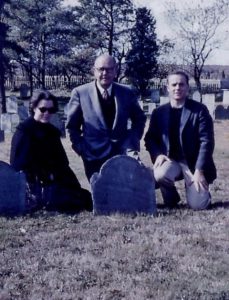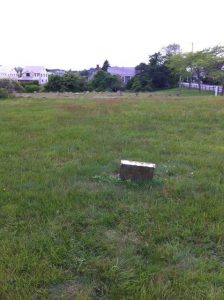
We’ve just been through Halloween, All Souls Day, and Dia de los Muertos, when society in general gives thought to skeletons, graveyards, and spirits of the departed. But whereas most folks have now packed away their plastic tombstones and ghost lights, we genealogists continue to haunt cemeteries in search of historic graves, and track down strangers whose living flesh matches that of our dead ancestors.
Long before the secrets of DNA were unlocked, humans have sensed the power in otherwise lifeless bones. Traditional Polynesian culture speaks of mana – spiritual energy – residing in bones, and relics have been treasured for centuries as a way of coming close to the holiness of Christian saints. Even elephants are known to caress the tusks and bones of their dead, somehow able to recognize the remains of elephants they’ve known in life.
We have a long tradition in America of setting aside places to remember the dead, but I wonder what genealogists will find in just a few generations. Where I live, cremation is the norm, and often people are stumped about what to do with the ashes. There are now many options besides burying them or placing them in a columbarium … and not all of them are even intentional.
I will confess to being old-fashioned; I really like the idea of having a place set apart where future generations … can come and pay their respects.
In our previous hometown of Forest Grove, someone decided to cast cremains over a cemetery from an airplane, but misguidedly tossed the entire bag out; this ended up punching a hole through the roof of a neighboring house, scattering ashes throughout the attic! And in the case of my paternal grandmother, “her ashes became more ashes” (as my aunt put it) when my father’s house burned to the ground in the 1991 Oakland Hills fire.
I will confess to being old-fashioned; I really like the idea of having a place set apart where future generations (who knows how many?) can come and pay their respects. Just a few days ago, I saw a note written in a child’s hand, tucked into a plaque at a local church’s columbarium: “So sad I never got to meet you. Doesn’t mean I can’t love you!” I think the young writer eloquently summed up the cry of every genealogist’s heart, and I’m thankful she had a place to go where she could feel connected to this personally unknown but important individual in her life.

I treasure a picture of my grandfather, father, and aunt taken at the grave of our seventeenth-century progenitor on Martha’s Vineyard.[1] In turn, my husband and I visited the same grave – as well as those of other ancestors nearby – on Father’s Day 2013. What an amazing gift to celebrate the festival of fatherhood, surrounded by my distant male ancestors and knowing that my father and grandfather had also been there!
During that same trip, I visited the grave of my great-great-great-great-grandfather, Captain Levi Starbuck,[2] on the nearby island of Nantucket. His is one of only five with markers in the “orthodox” section of the Quaker Cemetery, and my husband likes to quip that “Levi is a man who stands alone in his field.” Over the past century and a half, the stone has tipped forward significantly, so that I had to lie prone on the ground in order to photograph its face. I was focused in the moment on the task at hand, but afterwards I realized that I had been lying just a few feet above the mortal remains of my ancestor. Several subsequent DNA matches with others in this line have caused me to look back at that encounter with awe, and I can imagine Levi saying: “This at last is bone of my bones and flesh of my flesh.”[3]
Notes
[1] Simon Athearn (c. 1642–1715).
[2] Levi Starbuck (1769–1849), son of Thomas Starbuck and Dinah Trott.
[3] Genesis 2:23a, English Standard Version of the Bible.
Do you have the data in findagrave.com?
I’m not positive I understand your question. I’ve submitted pictures on findagrave for both Simon Athearn and Levi Starbuck, as well as for Simon’s wife. The face of Mary (Butler) Athearn’s gravestone entirely sheared off sometime after the photo of my family was taken (the edge is in front of my aunt), but I found a circus 1905 photo online, when it was well preserved and perfectly legible.
I live in a golf course community with 162 holes of golf in a 5-mile radius in the different communities. Honest, some people (after dark) sprinkle the ashes on the golf course.
That was very moving. Thank you.
Lovely post. Two comments. Halloween takes its name from All Hallows Eve, the night before All Saints Day on Nov. 1. The next day, Nov. 2, is All Souls Day. And I do think it is sad that people’s remains are disposed of so casually. Some even turned up recently in a charity donation bin. As for me, full body burial with the rites of my religion in a family plot. I already put my name on the stone in case my kids forget!
I agree — our remains are sacred and we should honor and remember the lives of our deceased loved ones by treating their remains with respect and dignity. No mantelpiece urn or custom jewelry made out of me, thank you — I’ve let my family know verbally and in my will what to do with me when I die.
I’m with you about being “old fashioned” and wanting my remains to be placed where they can be visited. This summer we attended the scattering of ashes into the Pacific Ocean for a relative. It was a nice ceremony, but there’s no marker for anyone to know he ever existed. A couple of years ago we visited a Northern California cemetery were my husband’s great-grandfather is laid — under his Civil War memorial tombstone. The cemetery records show the name of his grandson who lies next to him, but there was no stone. So we bought one for the little boy who otherwise would not be known to the world.
Looks like Pamela is a distant cousin. (Assuming my research is correct.)
David,
If you’re a distant cousin of Pamela’s, then you and I may also be what my mother used to call shirttail relatives. My g grandfather Moses Jewett, who I mentioned in response to her yesterday’s post, was b. in Hollis, NH, ca 1790 and m. there to a Eunice Andrews b. 1792 in an unknown place. They moved to Cleveland between 1814 and 1816, going by the birthplaces of their children. Eunice died in Cleveland in 1835 and Moses married in 1836 to Adaline Athearn, b. 13 Mar 1799 on Martha’s Vineyard. I call her a shirttail relative because the connection is one of marriage, not direct lineage. Adaline’s parents were George, b. 1754, d. 1837, and Hepsipah Hussey, b. 1761 on Martha’s Vineyard, m. unknown, d. d. 1842. Adaline had 7 children by her first husband, Joshua A. Adams, b. 1791 on Martha’s Vineyard. Joshua’s father was Francis Frederick Adams. That’s as far back as I know; the major source is “Jewett, Frederic Clarke. History and Genealogy of the Jewetts of America Vol. 1.” New York: The Grafton Press, 1908.” I’m fairly sure there is a newer version, but this is the one I saw 10-15 years ago.
Doris
Doris, It looks like you and I are related by marriage to both the Henry Adams of Braintree family and the Simon Athearn family on Martha’s Vineyard. Both links can be looked at the the History of Martha’s Vineyard, vol 3.
I also have Starbucks on Nantucket – one married to a Cogshell
Thinking of these lines here —
“Just a few days ago, I saw a note written in a child’s hand, tucked into a plaque at a local church’s columbarium: “So sad I never got to meet you. Doesn’t mean I can’t love you!” I think the young writer eloquently summed up the cry of every genealogist’s heart . . . .”
— I wholeheartedly agree with the sentiment. This is why I’ve posted on my own genealogy homepage and in my Find-A-Grave profile this old anonymous poem that was printed on the frontispiece of B. Frank Severance’s “History of the Stewarts of Londonderry, New Hampshire” (a book about one line of my late mother’s Scots-Irish ancestors):
“The profit of my living long ago
I dedicated to the unloving dead,
Though all my service they shall never know
Whose world is vanished and their name unsaid.
“For none remembers now the good, the ill
They did, the deeds they thought should last for aye;
But in the little room my voice can fill
They shall not be forgotten till I die.
“So, in a lonely churchyard by the shore,
The sea winds sift the sand across the mounds
And those forgotten graves are found no more,
And no man knows the churchyard’s holy bounds;
“Till one comes by and stoops with reverent hands
To clear the graves of their encumbering sands.”
That’s really beautiful. Thank you for sharing.
My son-in-law’s mother died a decade ago. She lived in urban Oakland Ca and was a committed A’s fan. After her death her son and his sister on a day the field was open to fans as part of some team event quietly carried her ashes on the field and scattered them that she might forever be with her beloved A’s.
I agree–I want to “keep” my bones underground and have an informative marker, but my husband wants to be cremated. I guess it’s irrational but I would prefer to have his old bones next to mine with a nice marker too.
Pamela, this was a lovely post–you are an excellent writer, which helps make you persuasive. It’s curious that my own mom was adamant she be cremated (giving me a letter regarding her final wishes, forty long and fun-filled years before she passed in 2012). My dad, on the other hand, has the opposite desire. Though I tend to lean toward the latter myself, there seem to be some very good and logical (and emotional) reasons on both sides of the ‘debate.’
My late uncle and aunt were cremated after death, but the small cemetery in the town they lived in all their lives allowed their last remains to be placed there, by “inurnment.” So there is a peaceful place where family can go to pay their respect. I wish more cemeteries would offer this option, which is more reasonable than paying thousands of dollars for a single grave.